醚氨基及氨基酸的各种保护基及去保护方法大全
- 格式:doc
- 大小:408.00 KB
- 文档页数:62
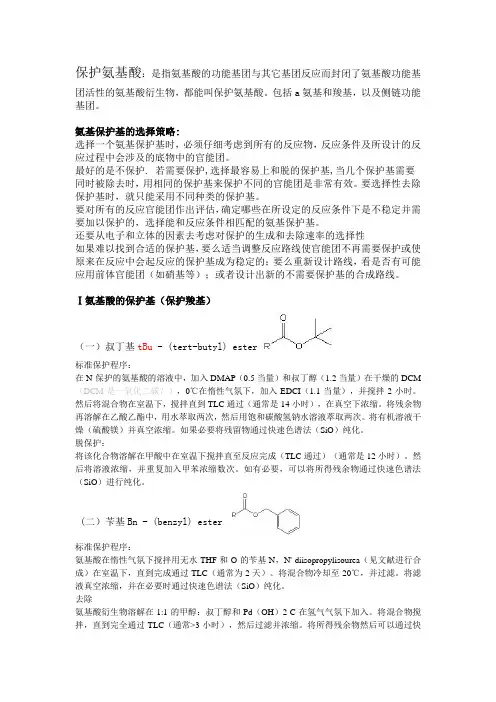
保护氨基酸:是指氨基酸的功能基团与其它基团反应而封闭了氨基酸功能基团活性的氨基酸衍生物,都能叫保护氨基酸。
包括a氨基和羧基,以及侧链功能基团。
氨基保护基的选择策略:选择一个氨基保护基时,必须仔细考虑到所有的反应物,反应条件及所设计的反应过程中会涉及的底物中的官能团。
最好的是不保护. 若需要保护,选择最容易上和脱的保护基,当几个保护基需要同时被除去时,用相同的保护基来保护不同的官能团是非常有效。
要选择性去除保护基时,就只能采用不同种类的保护基。
要对所有的反应官能团作出评估,确定哪些在所设定的反应条件下是不稳定并需要加以保护的,选择能和反应条件相匹配的氨基保护基。
还要从电子和立体的因素去考虑对保护的生成和去除速率的选择性如果难以找到合适的保护基,要么适当调整反应路线使官能团不再需要保护或使原来在反应中会起反应的保护基成为稳定的;要么重新设计路线,看是否有可能应用前体官能团(如硝基等);或者设计出新的不需要保护基的合成路线。
Ⅰ氨基酸的保护基(保护羧基)(一)叔丁基tBu - (tert-butyl) ester标准保护程序:在N-保护的氨基酸的溶液中,加入DMAP(0.5当量)和叔丁醇(1.2当量)在干燥的DCM (DCM是一氧化二碳?),0℃在惰性气氛下,加入EDCI(1.1当量),并搅拌2小时。
然后将混合物在室温下,搅拌直到TLC通过(通常是14小时),在真空下浓缩。
将残余物再溶解在乙酸乙酯中,用水萃取两次,然后用饱和碳酸氢钠水溶液萃取两次。
将有机溶液干燥(硫酸镁)并真空浓缩。
如果必要将残留物通过快速色谱法(SiO)纯化。
脱保护:将该化合物溶解在甲酸中在室温下搅拌直至反应完成(TLC通过)(通常是12小时)。
然后将溶液浓缩,并重复加入甲苯浓缩数次。
如有必要,可以将所得残余物通过快速色谱法(SiO)进行纯化。
(二)苄基Bn - (benzyl) ester标准保护程序:氨基酸在惰性气氛下搅拌用无水THF和O的苄基N,N'-diisopropylisourea(见文献进行合成)在室温下,直到完成通过TLC(通常为2天)。
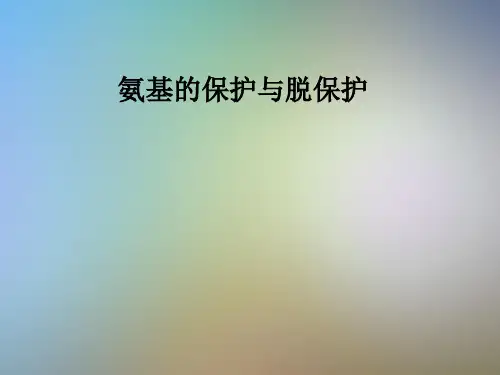
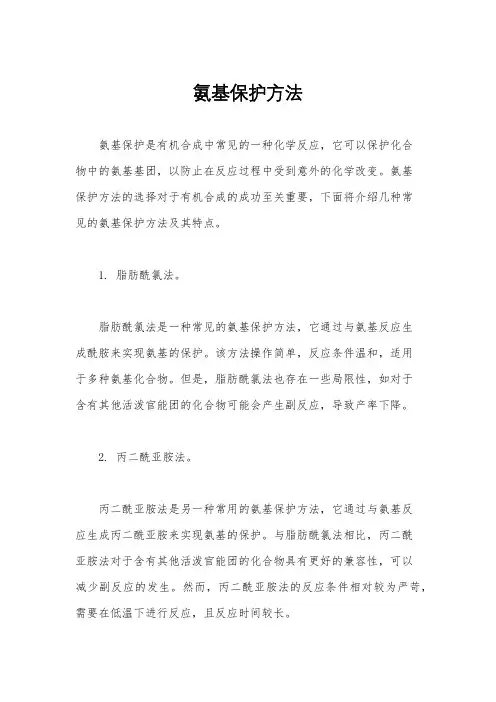
氨基保护方法氨基保护是有机合成中常见的一种化学反应,它可以保护化合物中的氨基基团,以防止在反应过程中受到意外的化学改变。
氨基保护方法的选择对于有机合成的成功至关重要,下面将介绍几种常见的氨基保护方法及其特点。
1. 脂肪酰氯法。
脂肪酰氯法是一种常见的氨基保护方法,它通过与氨基反应生成酰胺来实现氨基的保护。
该方法操作简单,反应条件温和,适用于多种氨基化合物。
但是,脂肪酰氯法也存在一些局限性,如对于含有其他活泼官能团的化合物可能会产生副反应,导致产率下降。
2. 丙二酰亚胺法。
丙二酰亚胺法是另一种常用的氨基保护方法,它通过与氨基反应生成丙二酰亚胺来实现氨基的保护。
与脂肪酰氯法相比,丙二酰亚胺法对于含有其他活泼官能团的化合物具有更好的兼容性,可以减少副反应的发生。
然而,丙二酰亚胺法的反应条件相对较为严苛,需要在低温下进行反应,且反应时间较长。
3. 三氯甲烷法。
三氯甲烷法是一种较为特殊的氨基保护方法,它通过与氨基反应生成三氯甲基化合物来实现氨基的保护。
该方法适用于对其他保护基敏感的化合物,可以避免副反应的发生。
然而,三氯甲烷法的操作相对较为复杂,需要在惰性气氛下进行反应,且对于一些氨基化合物可能存在选择性不足的问题。
4. 肟醚法。
肟醚法是一种较为温和的氨基保护方法,它通过与氨基反应生成肟醚化合物来实现氨基的保护。
该方法操作简便,反应条件温和,适用于多种氨基化合物。
然而,肟醚法在一些情况下可能会产生副反应,导致产率下降。
综上所述,氨基保护方法的选择应根据具体的化合物结构和反应条件来进行合理的考虑。
在实际应用中,我们可以根据需要综合考虑不同氨基保护方法的特点,选择最适合的方法进行保护,以确保有机合成的顺利进行。
希望本文介绍的氨基保护方法能为有机化学领域的研究工作提供一定的参考价值。

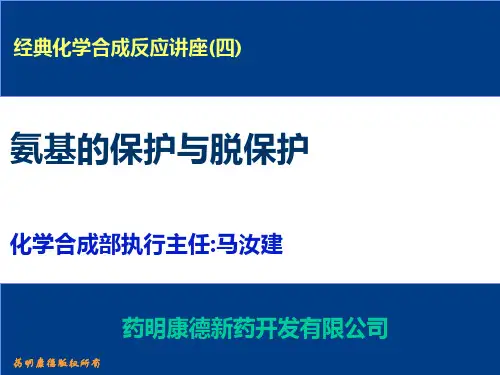
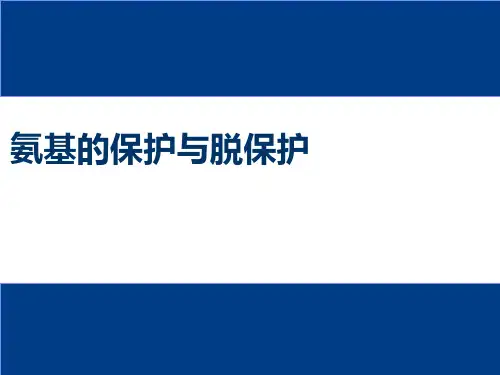
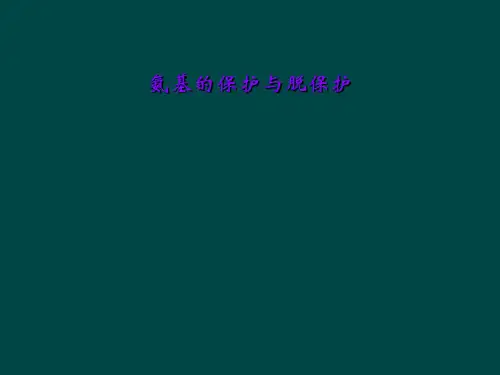
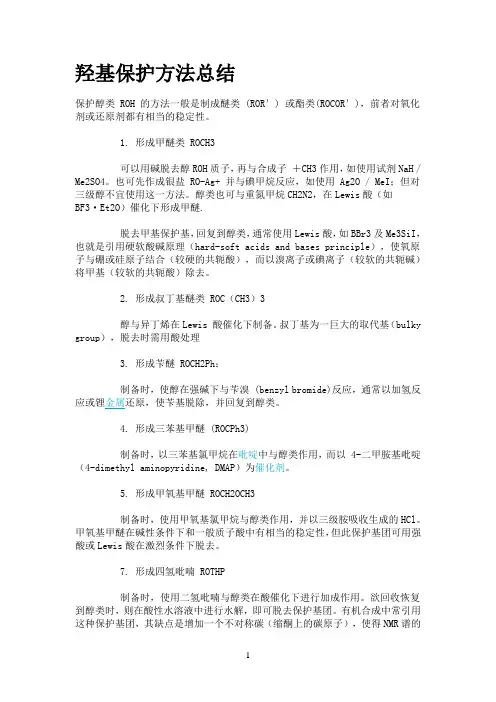
羟基保护方法总结保护醇类 ROH 的方法一般是制成醚类(ROR′) 或酯类(ROCOR′),前者对氧化剂或还原剂都有相当的稳定性。
1. 形成甲醚类 ROCH3可以用碱脱去醇ROH质子,再与合成子+CH3作用,如使用试剂NaH / Me2SO4。
也可先作成银盐 RO-Ag+ 并与碘甲烷反应,如使用 Ag2O / MeI;但对三级醇不宜使用这一方法。
醇类也可与重氮甲烷CH2N2,在Lewis酸(如BF3·Et2O)催化下形成甲醚.脱去甲基保护基,回复到醇类,通常使用Lewis酸,如BBr3及Me3SiI,也就是引用硬软酸碱原理(hard-soft acids and bases principle),使氧原子与硼或硅原子结合(较硬的共轭酸),而以溴离子或碘离子(较软的共轭碱)将甲基(较软的共轭酸)除去。
2. 形成叔丁基醚类 ROC(CH3)3醇与异丁烯在Lewis 酸催化下制备。
叔丁基为一巨大的取代基(bulky group),脱去时需用酸处理3. 形成苄醚 ROCH2Ph:制备时,使醇在强碱下与苄溴 (benzyl bromide)反应,通常以加氢反应或锂金属还原,使苄基脱除,并回复到醇类。
4. 形成三苯基甲醚 (ROCPh3)制备时,以三苯基氯甲烷在吡啶中与醇类作用,而以 4-二甲胺基吡啶(4-dimethyl aminopyridine, DMAP)为催化剂。
5. 形成甲氧基甲醚 ROCH2OCH3制备时,使用甲氧基氯甲烷与醇类作用,并以三级胺吸收生成的HCl。
甲氧基甲醚在碱性条件下和一般质子酸中有相当的稳定性,但此保护基团可用强酸或Lewis酸在激烈条件下脱去。
7. 形成四氢吡喃 ROTHP制备时,使用二氢吡喃与醇类在酸催化下进行加成作用。
欲回收恢复到醇类时,则在酸性水溶液中进行水解,即可脱去保护基团。
有机合成中常引用这种保护基团,其缺点是增加一个不对称碳(缩酮上的碳原子),使得NMR谱的解析较复杂。

有机合成中的重要保护基团和去保护方法在有机合成中,保护基团扮演着至关重要的角色。
它们可以保护反应中的特定功能团,以防止其与其他试剂发生不必要的反应。
保护基团的引入和去除成为了有机合成中的两个关键步骤。
在本文中,我们将探讨一些有机合成中的重要保护基团,以及去除它们的方法。
1. 醇保护基团醇保护基团是有机合成中最常用的保护基团之一。
它可以通过与醇反应生成醚来引入。
常用的醇保护基团包括醇酯、醚和醇醚。
在选取保护基团时,需要考虑其稳定性和去保护的条件。
去除醇保护基团的方法有很多种。
常用的方法包括酸处理和还原。
酸处理通常使用强酸,如硫酸、盐酸或三氟甲磺酸。
还原方法则是使用还原试剂,如铝醇盐或氢化钠。
2. 酰基保护基团酰基保护基团是保护羧酸的常用基团。
它可以通过与酸反应生成酯来引入。
常用的酰基保护基团包括乙酰基、苄酰基和丙酰基。
选择合适的酰基保护基团需要考虑其稳定性和易于去除的条件。
去除酰基保护基团的方法主要有碱处理和酸处理。
碱处理通常使用碱性试剂,如碳酸氢钠或氢氧化钠。
酸处理则使用酸性试剂,如盐酸或三氟甲磺酸。
3. 氨基保护基团氨基保护基团常用于保护胺官能团。
常用的氨基保护基团包括铺地基(Boc)、苄基、三甲基硅基(TMS)和甲酰基。
选择保护基团需要考虑其稳定性和去除的条件。
去除氨基保护基团的方法有多种。
常用的方法包括酸处理和碱处理。
酸处理通常使用强酸,如三氟甲磺酸或盐酸。
碱处理通常使用氢氧化钠或氢氧化铯。
4. 硅基保护基团硅基保护基团常用于保护醇和酚官能团。
常用的硅基保护基团包括二甲基氧硅基(TBS)、二异丙基氧硅基(TIPS)和三甲基硅基(TMS)。
选择硅基保护基团需要考虑其稳定性和去除的条件。
去除硅基保护基团的方法主要是酸处理。
常用的酸处理试剂包括氢氟酸、三氟甲磺酸和硼氟酸。
总结起来,有机合成中的保护基团起着至关重要的作用。
正确选择保护基团可以有效地保护特定的功能团,而去除保护基团则是合成目标化合物的关键步骤。
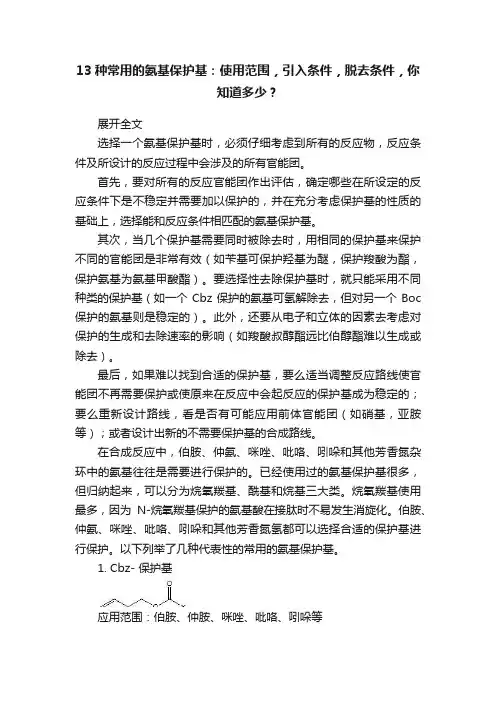
13种常用的氨基保护基:使用范围,引入条件,脱去条件,你知道多少?展开全文选择一个氨基保护基时,必须仔细考虑到所有的反应物,反应条件及所设计的反应过程中会涉及的所有官能团。
首先,要对所有的反应官能团作出评估,确定哪些在所设定的反应条件下是不稳定并需要加以保护的,并在充分考虑保护基的性质的基础上,选择能和反应条件相匹配的氨基保护基。
其次,当几个保护基需要同时被除去时,用相同的保护基来保护不同的官能团是非常有效(如苄基可保护羟基为醚,保护羧酸为酯,保护氨基为氨基甲酸酯)。
要选择性去除保护基时,就只能采用不同种类的保护基(如一个Cbz保护的氨基可氢解除去,但对另一个Boc 保护的氨基则是稳定的)。
此外,还要从电子和立体的因素去考虑对保护的生成和去除速率的影响(如羧酸叔醇酯远比伯醇酯难以生成或除去)。
最后,如果难以找到合适的保护基,要么适当调整反应路线使官能团不再需要保护或使原来在反应中会起反应的保护基成为稳定的;要么重新设计路线,看是否有可能应用前体官能团(如硝基,亚胺等);或者设计出新的不需要保护基的合成路线。
在合成反应中,伯胺、仲氨、咪唑、吡咯、吲哚和其他芳香氮杂环中的氨基往往是需要进行保护的。
已经使用过的氨基保护基很多,但归纳起来,可以分为烷氧羰基、酰基和烷基三大类。
烷氧羰基使用最多,因为N-烷氧羰基保护的氨基酸在接肽时不易发生消旋化。
伯胺、仲氨、咪唑、吡咯、吲哚和其他芳香氮氢都可以选择合适的保护基进行保护。
以下列举了几种代表性的常用的氨基保护基。
1. Cbz- 保护基应用范围:伯胺、仲胺、咪唑、吡咯、吲哚等引入条件:Cbz-Cl/Na2CO3/CHCl3/H2O脱去条件:H2/Pd-C,供氢体/Pd-C,BBr3/CH2Cl2 or TFA,HBr/HOAc等2. Boc- 保护基应用范围:伯胺、仲胺、咪唑、吡咯、吲哚等引入条件:Boc2O/NaOH/diox/H2O, Boc2O/ /MeOH, Boc2O/Me4NOH/CH3CN脱去条件:3MHCl/EtOAc, HCl/MeOH or diox, TosOH/THF-CH2Cl2, Me3SiI/CHCl3orCH3CN3. Fmoc-保护基应用范围:伯胺、仲胺等引入条件:Fmoc-Cl/NaHCO3,/diox/H2O脱去条件:20%哌啶/DMF,50%哌啶/CH2Cl2等4. Alloc-保护基应用范围:伯胺、仲胺、咪唑、吡咯、吲哚等引入条件:Aloc-Cl/Py脱去条件:Ni(CO)4/DMF/H2O; Pd(PPh3)4/Bu3SnH5. Teoc- 保护基应用范围:伯胺、仲胺、咪唑、吡咯、吲哚等引入条件:T eoc-Cl/碱/diox/H2O脱去条件:TBAF;TEAF6. 甲(乙)氧羰基- 保护基应用范围:伯胺、仲胺、咪唑、吡咯、吲哚等引入条件:ROCOCl/NaHCO3,/diox/H2O脱去条件:HBr/HOAc; Me3SiI; KOH/H2O/乙二醇7. Pht- 保护基应用范围:伯胺引入条件:邻苯二甲酸酐/CHCl3/70℃;邻苯二甲酰亚胺-NCO2Et/aq. Na2CO3脱去条件:H2NNH2/EtOH,NaBH4/i-PrOH-H2O(6:1)8. Tos- 保护基应用范围:伯胺、仲胺、咪唑、吡咯、吲哚等引入条件:T os-Cl/Et3N脱去条件:HBr/HOAc, 48%HBr/苯酚(cat)9. Tfa- 保护基应用范围:伯胺、仲胺、咪唑、吡咯、吲哚等引入条件:TFAA/Py; 苯二甲酰亚胺-NCO2CF3/CH2Cl2脱去条件:K2CO3/MeOH/H2O; NH3/MeOH; HCl/MeOH10. Trt- 保护基应用范围:伯胺、仲胺、咪唑、吡咯、吲哚等引入条件:Trt-Cl/Et3N脱去条件:HCl/MeOH, H2/Pd/EtOH, TFA/CH2Cl211.Dmb - 保护基应用范围:伯胺、仲胺、咪唑、吡咯、吲哚等引入条件:ArCHO/NaCNBH3/MeOH12. PMB- 保护基应用范围:伯胺、仲胺、咪唑、吡咯、吲哚等引入条件:PMB-Br/ K2CO3/CH3CN;PhCHO/NaCNBH3/MeOH脱去条件:HCO2H/Pd-C/MeOH; H2/Pd(OH)2/EtOH; TFA; CAN/ CH3CN13. Bn- 保护基应用范围:伯胺、仲胺、咪唑、吡咯、吲哚等引入条件:Bn-Br/Et3N or K2CO3/CH3CN;PhCHO/NaCNBH3/MeOH脱去条件:HCO2H/Pd-C/MeOH; H2/Pd(OH)2/EtOH; CCl3CH2OCOCl/CH3CN摘自:有机合成中的保护基欢迎加入“漫游药化交流10群”。
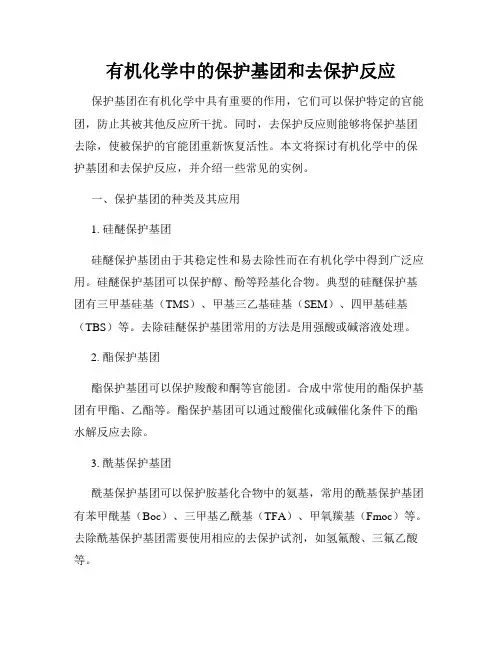
有机化学中的保护基团和去保护反应保护基团在有机化学中具有重要的作用,它们可以保护特定的官能团,防止其被其他反应所干扰。
同时,去保护反应则能够将保护基团去除,使被保护的官能团重新恢复活性。
本文将探讨有机化学中的保护基团和去保护反应,并介绍一些常见的实例。
一、保护基团的种类及其应用1. 硅醚保护基团硅醚保护基团由于其稳定性和易去除性而在有机化学中得到广泛应用。
硅醚保护基团可以保护醇、酚等羟基化合物。
典型的硅醚保护基团有三甲基硅基(TMS)、甲基三乙基硅基(SEM)、四甲基硅基(TBS)等。
去除硅醚保护基团常用的方法是用强酸或碱溶液处理。
2. 酯保护基团酯保护基团可以保护羧酸和酮等官能团。
合成中常使用的酯保护基团有甲酯、乙酯等。
酯保护基团可以通过酸催化或碱催化条件下的酯水解反应去除。
3. 酰基保护基团酰基保护基团可以保护胺基化合物中的氨基,常用的酰基保护基团有苯甲酰基(Boc)、三甲基乙酰基(TFA)、甲氧羰基(Fmoc)等。
去除酰基保护基团需要使用相应的去保护试剂,如氢氟酸、三氟乙酸等。
二、去保护反应的应用1.硅醚的去保护硅醚保护基团可以通过酸或碱处理去除。
常用的去保护试剂是氟化银(AgF)和氟化铵(NH4F),它们可以有效去除硅醚保护基团,还原羟基的反应活性。
2. 酯的去保护酯保护基团可以通过酸催化的水解或酸催化的醇ysis反应去除。
常用的去保护试剂是浓氢氧化钠(NaOH)、甲醇、乙醇等。
在合适的条件下,酯保护基团可以选择性地去除,而不影响其他官能团。
3. 酰基的去保护酰基保护基团可以通过使用酸或碱去保护试剂去除。
例如,苯甲酰基(Boc)保护基团可以使用三氟乙酸或氢氟酸处理去除。
甲氧羰基(Fmoc)保护基团可以通过用碱处理去除。
这些去保护反应一般是在温和的条件下进行。
三、实例展示1. 硅醚保护例如,对于芳香醇类化合物,可以使用TMS作为保护基团,合成过程中保护羟基,避免其在反应中被氧化或其他官能团干扰。
氨基常用保护方法用化学方程式表示(最新版4篇)篇1 目录1.氨基保护的重要性2.常用氨基保护方法及其化学方程式2.1 对苯环硝化的同时保护氨基2.2 乙酸酐保护氨基2.3 氨基保护策略2.4 保护基的选择和匹配2.5 保护基的脱除2.6 几个代表性的常用氨基保护基篇1正文氨基常用保护方法用化学方程式表示在化学合成中,氨基的保护是非常重要的。
由于氨基具有一定的活性,容易参与反应,因此在许多合成过程中,需要对氨基进行保护。
下面我们将介绍一些常用的氨基保护方法及其化学方程式。
首先,我们来看对苯环硝化的同时保护氨基的方法。
在这个过程中,我们通常使用乙酸酐作为保护基。
反应方程式如下:c6h5nh2 + ch3co-o-occh3 (乙酸酐) → c6h5nhcoch3在这个反应中,乙酸酐与氨基反应生成相应的氨基甲酸酯,从而实现对氨基的保护。
在实际应用中,我们需要根据反应条件和反应物来选择合适的保护基。
保护策略包括评估反应中的所有官能团,选择能与反应条件相匹配的氨基保护基。
当需要同时去除多个保护基时,使用相同的保护基来保护不同的官能团是非常有效的。
在保护基的选择和匹配方面,我们需要考虑保护基的稳定性、反应条件以及与反应物的匹配程度。
例如,在羧酸叔醇酯和伯醇酯之间,羧酸叔醇酯更难以生成或除去。
因此,在选择保护基时,我们需要从多个方面进行权衡。
当难以找到合适的保护基时,我们可以尝试调整反应路线,使官能团不再需要保护,或者设计新的合成路线。
常用的氨基保护基可以分为烷氧羰基、酰基和烷基三大类。
以下是几个代表性的常用氨基保护基:1.Cbz-保护基:适用于伯胺、仲胺、咪唑、吡咯、吲哚等。
引入条件:Cbz-Cl + Na2CO3 + CHCl3 + H2O脱去条件:H2Pd-C,供氢体 Pd-C,BBr3 + CH2Cl2 或 TFA2.乙酸酐保护基:适用于对苯环硝化等反应。
引入条件:ch3co-o-occh3 + NH2-R脱去条件:NaOH + H2O总之,在化学合成过程中,选择合适的氨基保护方法及其化学方程式是非常重要的。
氨基保护基及脱除条件
氨基保护基是指用于有机合成中的一种化学物质,这种物质可以保护有机物的反应基团不被氧化和过度反应的情况。
在有机合成中,常见的氨基保护基有以下几种:Fmoc(氟甲基奎尼酰胺)、Boc(丁醇酸)和tBu(叔丁基)等。
氨基保护基通常在有机合成中被使用,保护有机物反应基团,以防止它们受到氧化或过度反应。
但是,当需要有机物的反应基团参与后续的反应时,就必须先脱除氨基保护基,以便反应基团重新暴露出来。
有时,只有部分环境或溶剂条件才能脱除氨基保护基。
为了脱除氨基保护基,必须选择正确的脱除条件,主要有以下几种:碱性溶剂(如醋酸钠、乙醇和乙醚);碱性溶剂/醋酸盐(如:氢氧化钠溶液);酸性溶剂(如:醋酸、硫酸和氟酸);氯仿(DMSO);Gaseous Trifluoromethylsulfuric Anhydride(TFA);Xenon Fluoride(XeF2)。
以上这些只是大致列出的脱除氨基保护基的一般条件,在有机合成实验中,应根据不同反应去选择最适合的脱除条件,以得到最佳的合成效果,节省实验时间和物质消耗。
总之,氨基保护基可以有效的保护有机物的反应基团,同时也可以在正确的环境和条件下被脱除。
因此,氨基保护基在有机合成中是非常重要的,在正确选择脱除条件的前提下,可以有助于有机物的反应基团重新暴露。
保护氨基酸:是指氨基酸的功能基团与其它基团反应而封闭了氨基酸功能基团活性的氨基酸衍生物,都能叫保护氨基酸。
包括a氨基和羧基,以及侧链功能基团。
氨基保护基的选择策略:选择一个氨基保护基时,必须仔细考虑到所有的反应物,反应条件及所设计的反应过程中会涉及的底物中的官能团。
最好的是不保护. 若需要保护,选择最容易上和脱的保护基,当几个保护基需要同时被除去时,用相同的保护基来保护不同的官能团是非常有效。
要选择性去除保护基时,就只能采用不同种类的保护基。
要对所有的反应官能团作出评估,确定哪些在所设定的反应条件下是不稳定并需要加以保护的,选择能和反应条件相匹配的氨基保护基。
还要从电子和立体的因素去考虑对保护的生成和去除速率的选择性如果难以找到合适的保护基,要么适当调整反应路线使官能团不再需要保护或使原来在反应中会起反应的保护基成为稳定的;要么重新设计路线,看是否有可能应用前体官能团(如硝基等);或者设计出新的不需要保护基的合成路线。
Ⅰ氨基酸的保护基(保护羧基)(一)叔丁基tBu - (tert-butyl) ester标准保护程序:在N-保护的氨基酸的溶液中,加入DMAP(0.5当量)和叔丁醇(1.2当量)在干燥的DCM (DCM是一氧化二碳?),0℃在惰性气氛下,加入EDCI(1.1当量),并搅拌2小时。
然后将混合物在室温下,搅拌直到TLC通过(通常是14小时),在真空下浓缩。
将残余物再溶解在乙酸乙酯中,用水萃取两次,然后用饱和碳酸氢钠水溶液萃取两次。
将有机溶液干燥(硫酸镁)并真空浓缩。
如果必要将残留物通过快速色谱法(SiO)纯化。
脱保护:将该化合物溶解在甲酸中在室温下搅拌直至反应完成(TLC通过)(通常是12小时)。
然后将溶液浓缩,并重复加入甲苯浓缩数次。
如有必要,可以将所得残余物通过快速色谱法(SiO)进行纯化。
(二)苄基Bn - (benzyl) ester标准保护程序:氨基酸在惰性气氛下搅拌用无水THF和O的苄基N,N'-diisopropylisourea(见文献进行合成)在室温下,直到完成通过TLC(通常为2天)。
醚、氨基及氨基酸的各种保护基及去保护方法大全(整理有详细操作)[Acetate] [Benzoatel] [Pivaloate] [Levulinate] [Back to Carb.Synthesis]Ac - (acetate) esterStandard Protection ProcedureTo a solution of the glycoside in dry pyridine (25 eq) under an inert atmosphere at room temperature, acetic anhydride (10 eq) is added and stirred until complete by TLC (usually 16 h). The reaction mixture is then poured into ice/water and extracted three times with chloroform. The combined organic layers are extracted with 3% HCl, saturated aqueous sodium bicarbonate, and water. The organic layer is then dried and concentrated in vacuo. The resulting residue is purified by flash chromatography (SiO2) if necessary.RemovalThe glycoside is dissolved in methanol and a solution of sodium methoxide in methanol (0.1 eq per -OAc) is added drop wise at 0°. The solution is warmed to room temperature and stirred under an inert atmosphere until complete by TLC (usually within a few hours). Amberlite cationic exchange resin is then added with vigorous stirring until the pH of the mixture is neutral. The mixture is then filtered and concentrated. The resulting residue is purified by flash chromatography (SiO2) if necessary.ORThe Glycoside is dissolved in methanol and hydrazine hydrate (15 eq per -OAc) is added in two portions over 1.5 hours. The solution is stirred at room temperature under an inert atmosphere until complete by TLC (usually 6 hours). The solution is then neutralized with glacial acetic acid. The mixture is filtered through celite and concentrated. The resulting residue is purified by flash chromatography (SiO2) if necessary. ReferencesJ. Org. Chem., 1996, 61, 6442-6445."Synthetic Methods for Carbohydrates" Lemieux, Ch 6, pg. 90-115.J. Chem. Soc., Perkin Trans. 1, 1996, 985-993.Bz - (benzoate) esterStandard Protection ProcedureTo a solution of the glycoside dissolved in dry pyridine (0.3M), benzoyl chloride (4 eq per -OH) is added at room temperature under an inert atmosphere and stirred until complete by TLC (usually 16 h). Methanol is added and the solution was concentrated in vacuo. The residue was dissolved in DCM and washed with water, saturated copper sulfate, and brine. The organic layer is dried and concentrated in vacuo. The resulting residue is purified by flash chromatography (SiO2) if necessary. RemovalThe glycoside is dissolved in MeOH and a solution of NaOH (2.5 eq per -OH) in MeOH is added slowly. The mixture is stirred at room temperature under an inert atmosphere till complete by TLC (usually 1 h) and then concentrated in vacuo. The residue is dissolved in ethyl acetate and the organic solution is washed twice with water, dried (sodium sulfate), and concentrated in vacuo. The resulting residue is purified by flash chromatography (SiO2) if necessary.ReferencesTetrahedron, 1970, 26, 803-812.Carb. Res., 1993, 244, 237-246.Piv - (pivaloate) esterStandard ProcedureThe glycoside is dissolved in pyridine:DCM 2:1 and cooled to -20°. PivCl (1.2 eq per -OH) is then added drop wise under an inert atmosphere and the result is stirred at 0° until complete by TLC (usually 8 h). The mixture is then diluted with DCM and extracted with 5% HCl twice and once with water. The organic layer is then dried (sodium sulfate) and concentrated in vacuo. The resulting residue is purified by flash chromatography (SiO2) if necessary.RemovalThe glycoside is dissolved in MeOH, and a solution of sodium methoxide in methanol (10 eq per -OH) is added drop wise at room temperature under an inert atmosphere and stirred until the reaction is complete by TLC (usually 24 h). Aqueous HCl (10%) is added to the solution until neutral and theresulting mixture is concentrated in vacuo. The residue is purified by flash chromatography (SiO2) if necessary.ReferencesTet. Asym. 2000, 295-303.J. Am. Chem. Soc. 1990, 112, 3693-3695.Lev - (levulinate) esterStandard Protection ProcedureTo a solution of the glycoside in dry pyridine at room temperature under an inert atmosphere, levulinic anhydride (2 eq) is added drop wise. The reaction was stirred until complete by TLC (usually 24 h) and ice water is added. The mixture is extracted with chloroform and then the organic layer is back extracted with brine, dried (sodium sulfate), and concentrated in vacuo. The resulting residue is purified by flash chromatography (SiO2) if necessary.RemovalThe glycoside is dissolved in pyridine and hydrazine hydrate (1M in pyridine:acetic acid 3:2) is added at room temperature under an inert atmosphere. After addition of hydrazine is sufficient to consume starting material completely by TLC (usually a few minutes),pentane-2,4-dione is added with cooling to quench the reaction. The mixture is diluted with chloroform and extracted once with water and once with brine. The organic layer is dried (sodium sulfate) and concentrated in vacuo. The residue is purified by flash chromatography (SiO2) if necessary.ReferencesJACS, 1975, 97, 1614-1615.Tet. Lett., 1976, 52, 4875-4878.[Benzyl] [Trityl] [PMP] [Allyl] [pMB] [Back to Carb. Synthesis] Bn - (benzyl) etherStandard Protection ProcedureTo a solution of sodium hydride (1.3 eq per -OH) in DMF, the glycoside (dissolved in DMF) is added drop wise at 0° under an inert atmosphere. The mixture is stirred for 30 minutes at 0° and benzyl bromide (1.3 eq per -OH) is added drop wise. *Note - a catalytic amount of TBAI or crown ether can be added. The reaction is stirred at room temperature until complete by TLC (usually 16 h) and methanol is added slowly to quench the reaction. The solution is then diluted with chloroform and water, extracted 3 times with water and once with brine. The organic layer is dried (sodium sulfate) and concentrated in vacuo. The resulting residue is purified by flash chromatography (SiO2) if necessary.ORTo a solution of the glycoside in DCM, benzyl trichloroacetimidate (2 eq per -OH) is added drop wise (as a solution in cyclohexane - see third reference) with TfOH (catalytic - >1mol%). The result is stirred at room temperature under inert atmosphere until complete by TLC (usually overnight). Saturated aqueous sodium bicarbonate is added and the mixture is diluted with DCM. The organic layer is extracted once with water, once with brine, dried (sodium sulfate), and concentrated in vacuo. The resulting residue is purified by flash chromatography (SiO2) if necessary.RemovalThe glycoside is dissolved in 1:1 MeOH:tBuOH and palladium hydroxide (0.1 eq) is added at room temperature. A hydrogen atmosphere is added (balloon pressure) and the reaction is stirred until complete by TLC (usually 16 h). The mixture is then filtered and concentrated. *Note - catalytic glacial acidic acid may be added if the reaction isn't complete. The resulting residue is purified by flash chromatography (SiO2) if necessary.ReferencesJ. Org. Chem., 1979, 44, 3442.J. Am. Chem. Soc., 1971, 93, 1746.Tr - (triphenyl methyl) or trityl etherStandard Protection ProcedureTo a solution of the glycoside, trityl chloride (1.1 eq for primary over secondary, 1.5 eq for each -OH otherwise), and triethylamine (1.5 eq for primary over secondary, 2 eq for each -OH otherwise) stirring in DMF under an inert atmosphere at room temperature, DMAP (0.05 eq) is added. The reaction is stirred until complete by TLC (usually overnight)and then poured into ice-water. The mixture is extracted with chloroform and the organic layer is washed with saturated aqueous ammonium chloride and water, dried (sodium sulfate), and concentrated in vacuo. The resulting residue is purified by flash chromatography (SiO2) if necessary.RemovalThe glycoside is dissolved in ethanol and 5% palladium on charcoal is added under a hydrogen atmosphere. The reaction is stirred until complete by TLC (usually overnight) and filtered. The solution is concentrated and the residue is purified by flash chromatography (SiO2) if necessary. ReferencesTet. Lett., 1979, 2, 95-98.JOC, 1978, 18, 2877-2881.pMB - (para-methoxy benzyl) etherStandard Protection ProcedureTo a solution of sodium hydride (1.3 eq per -OH) in DMF, the glycoside (dissolved in DMF) is added drop wise at 0° under an inertatmosphere. The mixture is stirred for 30 minutes at 0° andpara-methoxybenzyl bromide (1.3 eq per -OH) is added drop wise. *Note - a catalytic amount of TBAI or crown ether can be added. The reaction is stirred at room temperature until complete by TLC (usually 16 h) and methanol is added slowly to quench the reaction. The solution is then diluted with chloroform and water, extracted 3 times with water and once with brine. The organic layer is dried (sodium sulfate) and concentrated in vacuo. The resulting residue is purified by flash chromatography (SiO2) if necessary.RemovalThe glycoside is dissolved in DCM/H2O 20:1 and DDQ (up to 10 eq) is added at room temperature under an inert atmosphere. The reaction is stirred until complete by TLC (usually 24 h, may require heat) and diluted with DCM. The solution is extracted with saturated aqueous sodium bicarbonate, dried (sodium sulfate), and concentrated in vacuo. Product can then be purified by column chromatography if necessary. The resulting residue is purified by flash chromatography (SiO2) if necessary. ReferencesJACS, 1992, 114, 2524-2536.JACS, 1996, 118, 9265-9270.Allyl - (allyl) etherStandard Protection ProcedureTo a solution of sodium hydride (1.3 eq per -OH) in DMF, the glycoside (dissolved in DMF) is added drop wise at 0° under an inert atmosphere. The mixture is stirred for 30 minutes at 0° and ally bromide (1.3 eq per -OH) is added drop wise. *Note - a catalytic amount of TBAI or crown ether can be added. The reaction is stirred at room temperature until complete by TLC (usually 16 h) and methanol is added slowly to quench the reaction. The solution is then diluted with chloroform and water, extracted 3 times with water and once with brine. The organic layer is dried (sodium sulfate) and concentrated in vacuo. The resulting residue is purified by flash chromatography (SiO2) if necessary.ORTo a solution of the glycoside in DCM, benzyl trichloroacetimidate (2 eq per -OH) is added drop wise (as a solution in cyclohexane - see third reference) with TfOH (catalytic - >1mol%). The result is stirred at room temperature under inert atmosphere until complete by TLC (usually overnight). Saturated aqueous sodium bicarbonate is added and the mixture is diluted with DCM. The organic layer is extracted once withwater, once with brine, dried (sodium sulfate), and concentrated in vacuo. The resulting residue is purified by flash chromatography (SiO2) if necessary.RemovalThe glycoside is dissolved in AcOH:water 20:1 and Palladium chloride (1.5 eq) followed by sodium acetate (5 eq) is added. The mixture is stirred under an inert atmosphere at room temperature until complete by TLC (usually overnight). Ethyl acetate is added and the mixture is extracted 2 times with saturated aqueous sodium bicarbonate. The organic layer is then extracted once with brine, dried (sodium sulfate), and concentrated in vacuo. The resulting residue is purified by flash chromatography (SiO2) if necessary.ReferencesTet. Lett., 1997, 40, 13,509-13,556.JOC, 1973, 18, 3224.J. Chem. Soc. Perkin Trans. I, 1985, 2247-2250.JACS, 1991, 113, 2092-2112.PMP - (p-methoxyphenyl) etherStandard Protection ProcedureTo a solution of the glycoside in THF under an inert atmosphere is added triphenylphosphine (1.3 eq), diethylazocarboxylate (1.3 eq), andp-methoxyphenol (3 eq). The resulting solution is heated to 80° and stirred until complete by TLC (usually 2 h). The mixture is concentrated in vacuo and purified by flash chromatography (SiO2).RemovalThe glycoside is dissolved in acetonitrile:water 4:1 at room temperature under an inert atmosphere and CAN (5 eq) is added. The mixture is stirred until complete by TLC (usually less than 1 h) and diluted with chloroform. The resulting solution is washed with water and saturated sodium chloride solution. The organic layer is dried (sodium sulfate) and concentrated in vacuo. The residue can then be purified by flash chromatography (SiO2) if necessary.ReferencesTet. Lett., 1988, 29, 1389-1390.Heterocycles, 1990, 31, 1555-1563.[TMS] [TES] [TIPS] [TBS] [TBDPS] [Back to Carb. Synthesis] TMS - (trimethyl silyl) etherStandard Protection ProcedureTo a solution of the glycoside and triethylamine (2 eq) stirring in THF at 0° under an inert atmosphere, is added drop wise TMS-Cl (1.5 eq). The result was allowed to warm to room temperature and stirred until complete by TLC (usually 6 h). The solution is then concentrated in vacuo and the residue taken on directly to next step.RemovalThe glycoside is dissolved in THF (~2M) and TBAF (1M solution in THF) is added drop wise at 0° under inert atmosphere. The reaction is allowed to warm to room temperature and stirred until complete by TLC (usually a few hours - if not complete in this time more TBAF solution may be added). *Note - equal volumes of glacial acetic acid (compared to TBAF solution.) may be added to prevent removal of acetates or other sensitive protecting groups. The reaction mixture is concentrated in vacuo and the residue is purified by flash chromatography (SiO2) if necessary.ReferencesJACS, 1972, 94, 2549-2550.TES - (triethyl silyl) etherStandard Protection ProcedureTo a solution of the glycoside and imidazole (2 eq) stirring in DMF at 0° under an inert atmosphere, is added drop wise TES-Cl (2 eq). The result is allowed to warm to room temperature and stirred until complete by TLC (usually overnight). An equal volume of ether is added and the reaction mixture is extracted three times with water and once with brine. The organic layer is dried (sodium sulfate) and concentrated in vacuo. The product can then be purified by flash chromatography (SiO2) if necessary. RemovalThe glycoside is dissolved in THF (~2M) and TBAF (1M solution in THF) was added drop wise at 0° under an inert atmosphere. The result is allowed to warm to room temperature and stirred until complete by TLC (usually a few hours - if not complete in this time more TBAF solution may be added). *Note - equal volume of glacial acetic acid (compared to TBAFsolution.) may be added to prevent removal of acetates or other sensitive protecting groups. The reaction mixture is concentrated in vacuo and the residue is purified by flash chromatography (SiO2) if necessary. ReferencesHelv. Chim. Acta, 1981, 64, 2002-2021.TIPS - (triisopropyl silyl) etherStandard Protection ProcedureTo a solution of the glycoside stirring in DMF at 0° under an inert atmosphere, TIPS-Cl (1.3 eq) and imidazole (1.5 eq) were added succinctly. The result was allowed to warm to room temperature and stirred until complete by TLC (usually overnight). The mixture is diluted with equal volume of chloroform and extracted three times with water and once with brine. The organic layer is dried (sodium sulfate) and concentrated in vacuo. The resulting residue is purified by flash chromatography (SiO2) if necessary.RemovalThe glycoside is dissolved in THF (~2M) and TBAF (1M solution in THF) was added drop wise at 0° under an inert atmosphere. The result is allowed to warm to room temperature and stirred until complete by TLC (usually a few hours - if not complete in this time more TBAF solution may be added). *Note - equal volume of glacial acetic acid (compared to TBAF solution.) may be added to prevent removal of acetates or other sensitive protecting groups. The reaction mixture is concentrated in vacuo and the residue is purified by flash chromatography (SiO2) if necessary. ReferencesJOC, 1980, 45, 4797-4798.TBS - (tert-butyl dimethyl silyl) etherStandard ProcedureTo a solution of the glycoside in DMF at 0° under an inert atmosphere, TBS-Cl (1.1 eq for selective primary -OH protection, 1.3 eq otherwise) and imidazole (1.3 to 1.5 eq) were added succinctly. The result was allowed to warm to room temperature and stirred until complete by TLC (usually overnight). The mixture is diluted with equal volume of chloroform andextracted three times with water and once with brine. The organic layer is dried (sodium sulfate) and concentrated in vacuo. The resulting residue is purified by flash chromatography (SiO2) if necessary.ORTo a solution of the glycoside and distilled 2,6-lutidine (2.1 eq) in dry DCM under an inert atmosphere at -78°, TBS-OTf is added drop wise over 30 minutes. The result is stirred until complete by TLC (usually 30 minutes - if not complete more TBS-OTf may be added) and methanol is added. The mixture is diluted with chloroform, washed with water and brine, dried over magnesium sulfate and concentrated in vacuo. The resulting residue is purified by flash chromatography (SiO2) if necessary.RemovalThe glycoside is dissolved in THF (~2M) and TBAF (1M solution in THF) was added drop wise at 0° under an inert atmosphere. The result is allowed to warm to room temperature and stirred until complete by TLC (usually a few hours - if not complete in this time more TBAF solution may be added). *Note - equal volume of glacial acetic acid (compared to TBAF solution.) may be added to prevent removal of acetates or other sensitive protecting groups. The reaction mixture is concentrated in vacuo and the residue is purified by flash chromatography (SiO2) if necessary. ReferencesJACS, 1997, 119, 449-450.JACS, 1972, 94, 6190-6191.JOC, 1987, 52, 622-635.TBDPS - (tert-butyl diphenyl silyl) etherStandard ProcedureThe glycoside is dissolved in DMF at room temperature under an inert atmosphere and treated with imidazole (2 eq per -OH) followed by TBDPS-Cl (1.5 eq per -OH). The reaction mixture is stirred until complete by TLC (usually overnight), diluted with ether and washed with 1M HCl followed by brine. The organic layer is dried (magnesium sulfate) and concentrated in vacuo. The resulting residue is purified by flash chromatography (SiO2) if necessary.RemovalTo a solution of the glycoside in THF at room temperature in a Nalgene container, commercially available 30% HF in pyridine is added drop wise under an inert atmosphere. The result is stirred until complete by TLC (usually 16 h) and diluted with slow addition of saturated sodium bicarbonate. Chloroform is added and the mixture is extractedsuccessively with water, saturated copper sulfate, and brine. The organic layer is then dried (sodium sulfate) and concentrated. The resulting residue is purified by flash chromatography (SiO2) if necessary. ReferencesJACS, 1997, 119, 449-450.Alcohol protection - [MOM] [MEM] [BOM] [SEM]Diol protection - [Acetonide] [Benzylidene][p-Methoxybenzylidene] [DTBS(OR)2] MOM - (methoxy methyl) etherStandard Protection ProcedureTo a solution of the glycoside in DCM (approx. 0.1M) and Hunig's base (N,N-diisopropylethyl amine, 2.0 eq) at 0°, MOM-Cl (1.5 eq) is added under an inert atmosphere. The reaction is warmed to room temperature and stirred until complete by TLC (usually >8 h). Ether is added and the mixture is washed 3 times with water and once with brine. The organic layer is dried (magnesium sulfate), filtered and concentrated in vacuo. The resulting residue is purified by flash chromatography (SiO2) if necessary.RemovalThe glycoside is dissolved in 1:1 THF:6N HCl and heated to 55° with stirring until the reaction is complete by TLC (usually 8 h). Saturated sodium chloride solution is then added and the reaction mixture isextracted three times with ether. The combined organic layers are dried (sodium sulfate), filtered and concentrated in vacuo. The residue is purified by flash chromatography (SiO2) if necessary.ReferencesJACS, 1977, 99, 1275-1276.JOC, 1975, 40, 2025-2029.MEM - (methoxy ethoxy methyl) etherStandard Protection ProcedureTo a solution of the glycoside and MEM-Cl (1.5 eq) in dry DCM, diisopropylethylamine (1.5 eq) is added and stirred at room temperature under an inert atmosphere until complete by TLC (usually 5 h). The reaction is diluted with DCM and extracted twice with water, once with brine, dried (sodium sulfate), and concentrated in vacuo. The resulting residue is purified by flash chromatography (SiO2) if necessary.ORTo a mixture of NaH (1.2 eq) stirring in THF at 0°, the glycoside is added drop wise (as solution in THF). After stirring for 30 minutes, MEM-Cl (1.5 eq) is added drop wise and reaction is allowed to warm to roomtemperature. The mixture is stirred until complete by TLC (usually overnight) and diluted with DCM. The mixture is then extracted twice with water, once with brine, dried (sodium sulfate), and concentrated in vacuo. The product is purified by flash chromatography (SiO2) if necessary.RemovalThe glycoside is dissolved in DCM and magnesium bromide etherate (excess) is added at room temperature under an inert atmosphere. The reaction is stirred until complete by TLC (usually >24 h), at which time water is added and stirred for 30 additional minutes. Aqueous HCl (1N) is added drop wise until the pH is 1-2 and the solution is clear. The resulting solution is extracted three times with ethyl acetate, dried (magnesium sulfate), and concentrated in vacuo. The resulting residue is purified by flash chromatography (SiO2) if necessary.ReferencesTet. Lett., 1976, 11, 809-812.JOC, 1994, 59, 2314-2323.J. Chem. Soc. Perkin Trans. I, 1985, 2247-2250.BOM - (benzyloxy methyl) etherStandard Protection ProcedureTo a solution of the glycoside in DCM (approx. 0.1M) and Hunig's base (N,N-diisopropylethyl amine, 2.0 eq) at 0°, BOM-Cl (1.2 eq) is added under an inert atmosphere. The reaction is warmed to room temperature and stirred until complete by TLC (usually >24 h). Ether is then added and the mixture is washed 3 times with water and once with brine. The organic layer is dried (magnesium sulfate), filtered and concentrated in vacuo. The resulting residue is purified by flash chromatography (SiO2) if necessary.RemovalThe glycoside is dissolved in EtOAc:Hex (1:2) and catalytic Pd(OH)2 is added (10mol%) under a hydrogen atmosphere. The reaction is stirred at room temperature until complete by TLC (usually a few hours). The mixture is then filtered and concentrated in vacuo. The residue is purified by flash chromatography (SiO2) if necessary.ReferencesJACS, 1975, 97, 6260.JACS, 1994, 116, 4674-4688.Tetrahedron, 1987, 43, 4395-4406.SEM - (trimethylsilyl) ethoxymethyl etherStandard ProcedureTo a solution of the glycoside under inert atmosphere at room temperature in DCM or THF (~2M), diisopropylethylamine (4 eq for each -OH) is added followed by the addition of SEM-Cl (3 eq for each -OH). The reaction is stirred until complete by TLC, at which time saturated ammonium chloride is added. The mixture is extracted with two portions of DCM and the combined organic layers are extracted twice with saturated bicarbonate and once with brine. The solution is then dried (magnesium sulfate), filtered, and concentrated in vacuo. The resulting residue is purified by flash chromatography (SiO2) if necessary.RemovalThe glycoside is dissolved in a 0.5M solution of sulfuric acid in 2:1 MeOH:THF at 0° under inert atmosphere. The reaction is stirred untilcomplete by TLC (usually <3 h) and saturated sodium bicarbonate solution is added slowly. The mixture is then diluted with ethyl acetate and separated. The aqueous layer is back extracted twice with ethyl acetate and the combined organic layers are extracted with saturated sodium bicarbonate and brine. The organic solution is then dried (magnesium sulfate), filtered, and concentrated in vacuo. The resulting residue is purified by flash chromatography (SiO2) if necessary.ReferencesTet. Lett, 1993, 12, 1991-1994Tet. Lett, 1980, 21, 3343-3346Acetonide - (isopropylidene) ketalStandard Protection ProcedureTo a solution of the glycoside stirring in DMF, p-toluenesulfonic acid (10mol%) and 2,2-dimethoxypropane are added. The result is stirred at room temperature under inert atmosphere until complete by TLC (usually >6 h). The reaction is neutralized with 5% aqueous sodium bicarbonate and concentrated in vacuo. The material is dissolved in ethyl acetate,washed with water, saturated sodium chloride, dried (sodium sulfate), and concentrated in vacuo. The product is then purified by flash chromatography (SiO2) if necessary.RemovalThe glycoside is dissolved in 80-90% AcOH in water and stirred at 60-90° until complete by TLC (usually <3 h). The solution is then concentrated in vacuo and purified by flash chromatography (SiO2) if necessary. ReferencesChem. Pharm. Bull., 1990, 38, 3366-3372. Benzylidene AcetalStandard Protection ProcedureThe glycoside is dissolved in DMF and benzyaldehyde dimethyl acetal (5 eq) is added. To this solution stirring at room temperature under an inert atmosphere, toluene-p-sulfonic acid (0.3 eq) is added. After the reaction is complete by TLC (usually overnight), the mixture is neutralized with triethylamine. The solution is then concentrated in vacuo and purified by flash chromatography (SiO2) if necessary.ORThe glycoside is dissolved in acetonitrile and benzyaldehyde dimethyl acetal (5 eq) is added. To this solution stirring at room temperature under inert atmosphere, toluene-p-sulfonic acid (0.3 eq) is added. After the reaction is complete by TLC (usually overnight), the mixture is diluted with chloroform and extracted twice with water. The aqueous layer is then back extracted with chloroform. The combined organic layers are dried and concentrated in vacuo. The resulting residue is purified by flash chromatography (SiO2) if necessary.Complete RemovalThe glycoside is dissolved in 50-80% AcOH in water and heated to 60-70° with stirring until complete by TLC (usually >4 h). The solution is then concentrated and coevaporated with toluene 3 times. The residue is purified by flash chromatography (SiO2) if necessary.ORTo a solution of the glycoside in methanol at room temperature under an inert atmosphere, toluene-p-sulfonic acid (0.3 eq) is added. The reaction is stirred until complete by TLC (usually overnight) and triethylamine is added to neutralize. The mixture is concentrated in vacuo and the residue is purified by flash chromatography (SiO2) if necessary.ORTo a solution of the glycoside in methanol:t-butanol 1:1 at roomtemperature under a hydrogen atmosphere, Pd(OH)2-C (20mol%) is added. The reaction is stirred until complete by TLC (usually overnight, if not complete up to one eq of HCl may be added) and filtered washing with methanol. The solution is concentrated in vacuo and the resulting residue is purified by flash chromatography (SiO2) if necessary.Partial RemovalFor primary benzyl and secondary -OH - To a solution of the glycoside in DCM under inert atmosphere at 0°, triethylsilane (5 eq) isadded. Trifluoroacetic acid (5 eq) is then added drop wise and the reaction mixture is allowed to warm to room temperature. The reaction is stirred until complete by TLC (usually <3 h) and diluted with DCM. The organic solution is then extracted twice with saturated aqueous sodium bicarbonate solution, dried (sodium sulfate), and concentrated in vacuo. The resulting residue is purified by flash chromatography (SiO2) if necessary.For secondary benzyl and primary -OH - To a solution of the glycoside dissolved in DCM under an inert atmosphere at room temperature, 4A molecular sieves are added and stirred for one hour. The mixture is then cooled to -78° and triethylsilane (3 eq) is added followed by PhBCl2 (3.4 eq). After stirring for one hour, triethylamine and methanol are added and the mixture is diluted with chloroform. The organic solution is washed with saturated aqueous sodium bicarbonate solution, dried (sodium。
醚、氨基及氨基酸的各种保护基及去保护方法大全(整理有详细操作)[Acetate] [Benzoatel] [Pivaloate] [Levulinate] [Back to Carb.Synthesis]Ac - (acetate) esterStandard Protection ProcedureTo a solution of the glycoside in dry pyridine (25 eq) under an inert atmosphere at room temperature, acetic anhydride (10 eq) is added and stirred until complete by TLC (usually 16 h). The reaction mixture is then poured into ice/water and extracted three times with chloroform. The combined organic layers are extracted with 3% HCl, saturated aqueous sodium bicarbonate, and water. The organic layer is then dried and concentrated in vacuo. The resulting residue is purified by flash chromatography (SiO2) if necessary.RemovalThe glycoside is dissolved in methanol and a solution of sodium methoxide in methanol (0.1 eq per -OAc) is added drop wise at 0°. The solution is warmed to room temperature and stirred under an inert atmosphere until complete by TLC (usually within a few hours). Amberlite cationic exchange resin is then added with vigorous stirring until the pH of the mixture is neutral. The mixture is then filtered and concentrated. The resulting residue is purified by flash chromatography (SiO2) if necessary.ORThe Glycoside is dissolved in methanol and hydrazine hydrate (15 eq per -OAc) is added in two portions over 1.5 hours. The solution is stirred at room temperature under an inert atmosphere until complete by TLC (usually 6 hours). The solution is then neutralized with glacial acetic acid. The mixture is filtered through celite and concentrated. The resulting residue is purified by flash chromatography (SiO2) if necessary. ReferencesJ. Org. Chem., 1996, 61, 6442-6445."Synthetic Methods for Carbohydrates" Lemieux, Ch 6, pg. 90-115.J. Chem. Soc., Perkin Trans. 1, 1996, 985-993.Bz - (benzoate) esterStandard Protection ProcedureTo a solution of the glycoside dissolved in dry pyridine (0.3M), benzoyl chloride (4 eq per -OH) is added at room temperature under an inert atmosphere and stirred until complete by TLC (usually 16 h). Methanol is added and the solution was concentrated in vacuo. The residue was dissolved in DCM and washed with water, saturated copper sulfate, and brine. The organic layer is dried and concentrated in vacuo. The resulting residue is purified by flash chromatography (SiO2) if necessary. RemovalThe glycoside is dissolved in MeOH and a solution of NaOH (2.5 eq per -OH) in MeOH is added slowly. The mixture is stirred at room temperature under an inert atmosphere till complete by TLC (usually 1 h) and then concentrated in vacuo. The residue is dissolved in ethyl acetate and the organic solution is washed twice with water, dried (sodium sulfate), and concentrated in vacuo. The resulting residue is purified by flash chromatography (SiO2) if necessary.ReferencesTetrahedron, 1970, 26, 803-812.Carb. Res., 1993, 244, 237-246.Piv - (pivaloate) esterStandard ProcedureThe glycoside is dissolved in pyridine:DCM 2:1 and cooled to -20°. PivCl (1.2 eq per -OH) is then added drop wise under an inert atmosphere and the result is stirred at 0° until complete by TLC (usually 8 h). The mixture is then diluted with DCM and extracted with 5% HCl twice and once with water. The organic layer is then dried (sodium sulfate) and concentrated in vacuo. The resulting residue is purified by flash chromatography (SiO2) if necessary.RemovalThe glycoside is dissolved in MeOH, and a solution of sodium methoxide in methanol (10 eq per -OH) is added drop wise at room temperature under an inert atmosphere and stirred until the reaction is complete by TLC (usually 24 h). Aqueous HCl (10%) is added to the solution until neutral and theresulting mixture is concentrated in vacuo. The residue is purified by flash chromatography (SiO2) if necessary.ReferencesTet. Asym. 2000, 295-303.J. Am. Chem. Soc. 1990, 112, 3693-3695.Lev - (levulinate) esterStandard Protection ProcedureTo a solution of the glycoside in dry pyridine at room temperature under an inert atmosphere, levulinic anhydride (2 eq) is added drop wise. The reaction was stirred until complete by TLC (usually 24 h) and ice water is added. The mixture is extracted with chloroform and then the organic layer is back extracted with brine, dried (sodium sulfate), and concentrated in vacuo. The resulting residue is purified by flash chromatography (SiO2) if necessary.RemovalThe glycoside is dissolved in pyridine and hydrazine hydrate (1M in pyridine:acetic acid 3:2) is added at room temperature under an inert atmosphere. After addition of hydrazine is sufficient to consume starting material completely by TLC (usually a few minutes),pentane-2,4-dione is added with cooling to quench the reaction. The mixture is diluted with chloroform and extracted once with water and once with brine. The organic layer is dried (sodium sulfate) and concentrated in vacuo. The residue is purified by flash chromatography (SiO2) if necessary.ReferencesJACS, 1975, 97, 1614-1615.Tet. Lett., 1976, 52, 4875-4878.[Benzyl] [Trityl] [PMP] [Allyl] [pMB] [Back to Carb. Synthesis] Bn - (benzyl) etherStandard Protection ProcedureTo a solution of sodium hydride (1.3 eq per -OH) in DMF, the glycoside (dissolved in DMF) is added drop wise at 0° under an inert atmosphere. The mixture is stirred for 30 minutes at 0° and benzyl bromide (1.3 eq per -OH) is added drop wise. *Note - a catalytic amount of TBAI or crown ether can be added. The reaction is stirred at room temperature until complete by TLC (usually 16 h) and methanol is added slowly to quench the reaction. The solution is then diluted with chloroform and water, extracted 3 times with water and once with brine. The organic layer is dried (sodium sulfate) and concentrated in vacuo. The resulting residue is purified by flash chromatography (SiO2) if necessary.ORTo a solution of the glycoside in DCM, benzyl trichloroacetimidate (2 eq per -OH) is added drop wise (as a solution in cyclohexane - see third reference) with TfOH (catalytic - >1mol%). The result is stirred at room temperature under inert atmosphere until complete by TLC (usually overnight). Saturated aqueous sodium bicarbonate is added and the mixture is diluted with DCM. The organic layer is extracted once with water, once with brine, dried (sodium sulfate), and concentrated in vacuo. The resulting residue is purified by flash chromatography (SiO2) if necessary.RemovalThe glycoside is dissolved in 1:1 MeOH:tBuOH and palladium hydroxide (0.1 eq) is added at room temperature. A hydrogen atmosphere is added (balloon pressure) and the reaction is stirred until complete by TLC (usually 16 h). The mixture is then filtered and concentrated. *Note - catalytic glacial acidic acid may be added if the reaction isn't complete. The resulting residue is purified by flash chromatography (SiO2) if necessary.ReferencesJ. Org. Chem., 1979, 44, 3442.J. Am. Chem. Soc., 1971, 93, 1746.Tr - (triphenyl methyl) or trityl etherStandard Protection ProcedureTo a solution of the glycoside, trityl chloride (1.1 eq for primary over secondary, 1.5 eq for each -OH otherwise), and triethylamine (1.5 eq for primary over secondary, 2 eq for each -OH otherwise) stirring in DMF under an inert atmosphere at room temperature, DMAP (0.05 eq) is added. The reaction is stirred until complete by TLC (usually overnight)and then poured into ice-water. The mixture is extracted with chloroform and the organic layer is washed with saturated aqueous ammonium chloride and water, dried (sodium sulfate), and concentrated in vacuo. The resulting residue is purified by flash chromatography (SiO2) if necessary.RemovalThe glycoside is dissolved in ethanol and 5% palladium on charcoal is added under a hydrogen atmosphere. The reaction is stirred until complete by TLC (usually overnight) and filtered. The solution is concentrated and the residue is purified by flash chromatography (SiO2) if necessary. ReferencesTet. Lett., 1979, 2, 95-98.JOC, 1978, 18, 2877-2881.pMB - (para-methoxy benzyl) etherStandard Protection ProcedureTo a solution of sodium hydride (1.3 eq per -OH) in DMF, the glycoside (dissolved in DMF) is added drop wise at 0° under an inertatmosphere. The mixture is stirred for 30 minutes at 0° andpara-methoxybenzyl bromide (1.3 eq per -OH) is added drop wise. *Note - a catalytic amount of TBAI or crown ether can be added. The reaction is stirred at room temperature until complete by TLC (usually 16 h) and methanol is added slowly to quench the reaction. The solution is then diluted with chloroform and water, extracted 3 times with water and once with brine. The organic layer is dried (sodium sulfate) and concentrated in vacuo. The resulting residue is purified by flash chromatography (SiO2) if necessary.RemovalThe glycoside is dissolved in DCM/H2O 20:1 and DDQ (up to 10 eq) is added at room temperature under an inert atmosphere. The reaction is stirred until complete by TLC (usually 24 h, may require heat) and diluted with DCM. The solution is extracted with saturated aqueous sodium bicarbonate, dried (sodium sulfate), and concentrated in vacuo. Product can then be purified by column chromatography if necessary. The resulting residue is purified by flash chromatography (SiO2) if necessary. ReferencesJACS, 1992, 114, 2524-2536.JACS, 1996, 118, 9265-9270.Allyl - (allyl) etherStandard Protection ProcedureTo a solution of sodium hydride (1.3 eq per -OH) in DMF, the glycoside (dissolved in DMF) is added drop wise at 0° under an inert atmosphere. The mixture is stirred for 30 minutes at 0° and ally bromide (1.3 eq per -OH) is added drop wise. *Note - a catalytic amount of TBAI or crown ether can be added. The reaction is stirred at room temperature until complete by TLC (usually 16 h) and methanol is added slowly to quench the reaction. The solution is then diluted with chloroform and water, extracted 3 times with water and once with brine. The organic layer is dried (sodium sulfate) and concentrated in vacuo. The resulting residue is purified by flash chromatography (SiO2) if necessary.ORTo a solution of the glycoside in DCM, benzyl trichloroacetimidate (2 eq per -OH) is added drop wise (as a solution in cyclohexane - see third reference) with TfOH (catalytic - >1mol%). The result is stirred at room temperature under inert atmosphere until complete by TLC (usually overnight). Saturated aqueous sodium bicarbonate is added and the mixture is diluted with DCM. The organic layer is extracted once withwater, once with brine, dried (sodium sulfate), and concentrated in vacuo. The resulting residue is purified by flash chromatography (SiO2) if necessary.RemovalThe glycoside is dissolved in AcOH:water 20:1 and Palladium chloride (1.5 eq) followed by sodium acetate (5 eq) is added. The mixture is stirred under an inert atmosphere at room temperature until complete by TLC (usually overnight). Ethyl acetate is added and the mixture is extracted 2 times with saturated aqueous sodium bicarbonate. The organic layer is then extracted once with brine, dried (sodium sulfate), and concentrated in vacuo. The resulting residue is purified by flash chromatography (SiO2) if necessary.ReferencesTet. Lett., 1997, 40, 13,509-13,556.JOC, 1973, 18, 3224.J. Chem. Soc. Perkin Trans. I, 1985, 2247-2250.JACS, 1991, 113, 2092-2112.PMP - (p-methoxyphenyl) etherStandard Protection ProcedureTo a solution of the glycoside in THF under an inert atmosphere is added triphenylphosphine (1.3 eq), diethylazocarboxylate (1.3 eq), andp-methoxyphenol (3 eq). The resulting solution is heated to 80° and stirred until complete by TLC (usually 2 h). The mixture is concentrated in vacuo and purified by flash chromatography (SiO2).RemovalThe glycoside is dissolved in acetonitrile:water 4:1 at room temperature under an inert atmosphere and CAN (5 eq) is added. The mixture is stirred until complete by TLC (usually less than 1 h) and diluted with chloroform. The resulting solution is washed with water and saturated sodium chloride solution. The organic layer is dried (sodium sulfate) and concentrated in vacuo. The residue can then be purified by flash chromatography (SiO2) if necessary.ReferencesTet. Lett., 1988, 29, 1389-1390.Heterocycles, 1990, 31, 1555-1563.[TMS] [TES] [TIPS] [TBS] [TBDPS] [Back to Carb. Synthesis] TMS - (trimethyl silyl) etherStandard Protection ProcedureTo a solution of the glycoside and triethylamine (2 eq) stirring in THF at 0° under an inert atmosphere, is added drop wise TMS-Cl (1.5 eq). The result was allowed to warm to room temperature and stirred until complete by TLC (usually 6 h). The solution is then concentrated in vacuo and the residue taken on directly to next step.RemovalThe glycoside is dissolved in THF (~2M) and TBAF (1M solution in THF) is added drop wise at 0° under inert atmosphere. The reaction is allowed to warm to room temperature and stirred until complete by TLC (usually a few hours - if not complete in this time more TBAF solution may be added). *Note - equal volumes of glacial acetic acid (compared to TBAF solution.) may be added to prevent removal of acetates or other sensitive protecting groups. The reaction mixture is concentrated in vacuo and the residue is purified by flash chromatography (SiO2) if necessary.ReferencesJACS, 1972, 94, 2549-2550.TES - (triethyl silyl) etherStandard Protection ProcedureTo a solution of the glycoside and imidazole (2 eq) stirring in DMF at 0° under an inert atmosphere, is added drop wise TES-Cl (2 eq). The result is allowed to warm to room temperature and stirred until complete by TLC (usually overnight). An equal volume of ether is added and the reaction mixture is extracted three times with water and once with brine. The organic layer is dried (sodium sulfate) and concentrated in vacuo. The product can then be purified by flash chromatography (SiO2) if necessary. RemovalThe glycoside is dissolved in THF (~2M) and TBAF (1M solution in THF) was added drop wise at 0° under an inert atmosphere. The result is allowed to warm to room temperature and stirred until complete by TLC (usually a few hours - if not complete in this time more TBAF solution may be added). *Note - equal volume of glacial acetic acid (compared to TBAFsolution.) may be added to prevent removal of acetates or other sensitive protecting groups. The reaction mixture is concentrated in vacuo and the residue is purified by flash chromatography (SiO2) if necessary. ReferencesHelv. Chim. Acta, 1981, 64, 2002-2021.TIPS - (triisopropyl silyl) etherStandard Protection ProcedureTo a solution of the glycoside stirring in DMF at 0° under an inert atmosphere, TIPS-Cl (1.3 eq) and imidazole (1.5 eq) were added succinctly. The result was allowed to warm to room temperature and stirred until complete by TLC (usually overnight). The mixture is diluted with equal volume of chloroform and extracted three times with water and once with brine. The organic layer is dried (sodium sulfate) and concentrated in vacuo. The resulting residue is purified by flash chromatography (SiO2) if necessary.RemovalThe glycoside is dissolved in THF (~2M) and TBAF (1M solution in THF) was added drop wise at 0° under an inert atmosphere. The result is allowed to warm to room temperature and stirred until complete by TLC (usually a few hours - if not complete in this time more TBAF solution may be added). *Note - equal volume of glacial acetic acid (compared to TBAF solution.) may be added to prevent removal of acetates or other sensitive protecting groups. The reaction mixture is concentrated in vacuo and the residue is purified by flash chromatography (SiO2) if necessary. ReferencesJOC, 1980, 45, 4797-4798.TBS - (tert-butyl dimethyl silyl) etherStandard ProcedureTo a solution of the glycoside in DMF at 0° under an inert atmosphere, TBS-Cl (1.1 eq for selective primary -OH protection, 1.3 eq otherwise) and imidazole (1.3 to 1.5 eq) were added succinctly. The result was allowed to warm to room temperature and stirred until complete by TLC (usually overnight). The mixture is diluted with equal volume of chloroform andextracted three times with water and once with brine. The organic layer is dried (sodium sulfate) and concentrated in vacuo. The resulting residue is purified by flash chromatography (SiO2) if necessary.ORTo a solution of the glycoside and distilled 2,6-lutidine (2.1 eq) in dry DCM under an inert atmosphere at -78°, TBS-OTf is added drop wise over 30 minutes. The result is stirred until complete by TLC (usually 30 minutes - if not complete more TBS-OTf may be added) and methanol is added. The mixture is diluted with chloroform, washed with water and brine, dried over magnesium sulfate and concentrated in vacuo. The resulting residue is purified by flash chromatography (SiO2) if necessary.RemovalThe glycoside is dissolved in THF (~2M) and TBAF (1M solution in THF) was added drop wise at 0° under an inert atmosphere. The result is allowed to warm to room temperature and stirred until complete by TLC (usually a few hours - if not complete in this time more TBAF solution may be added). *Note - equal volume of glacial acetic acid (compared to TBAF solution.) may be added to prevent removal of acetates or other sensitive protecting groups. The reaction mixture is concentrated in vacuo and the residue is purified by flash chromatography (SiO2) if necessary. ReferencesJACS, 1997, 119, 449-450.JACS, 1972, 94, 6190-6191.JOC, 1987, 52, 622-635.TBDPS - (tert-butyl diphenyl silyl) etherStandard ProcedureThe glycoside is dissolved in DMF at room temperature under an inert atmosphere and treated with imidazole (2 eq per -OH) followed by TBDPS-Cl (1.5 eq per -OH). The reaction mixture is stirred until complete by TLC (usually overnight), diluted with ether and washed with 1M HCl followed by brine. The organic layer is dried (magnesium sulfate) and concentrated in vacuo. The resulting residue is purified by flash chromatography (SiO2) if necessary.RemovalTo a solution of the glycoside in THF at room temperature in a Nalgene container, commercially available 30% HF in pyridine is added drop wise under an inert atmosphere. The result is stirred until complete by TLC (usually 16 h) and diluted with slow addition of saturated sodium bicarbonate. Chloroform is added and the mixture is extractedsuccessively with water, saturated copper sulfate, and brine. The organic layer is then dried (sodium sulfate) and concentrated. The resulting residue is purified by flash chromatography (SiO2) if necessary. ReferencesJACS, 1997, 119, 449-450.Alcohol protection - [MOM] [MEM] [BOM] [SEM]Diol protection - [Acetonide] [Benzylidene][p-Methoxybenzylidene] [DTBS(OR)2] MOM - (methoxy methyl) etherStandard Protection ProcedureTo a solution of the glycoside in DCM (approx. 0.1M) and Hunig's base (N,N-diisopropylethyl amine, 2.0 eq) at 0°, MOM-Cl (1.5 eq) is added under an inert atmosphere. The reaction is warmed to room temperature and stirred until complete by TLC (usually >8 h). Ether is added and the mixture is washed 3 times with water and once with brine. The organic layer is dried (magnesium sulfate), filtered and concentrated in vacuo. The resulting residue is purified by flash chromatography (SiO2) if necessary.RemovalThe glycoside is dissolved in 1:1 THF:6N HCl and heated to 55° with stirring until the reaction is complete by TLC (usually 8 h). Saturated sodium chloride solution is then added and the reaction mixture isextracted three times with ether. The combined organic layers are dried (sodium sulfate), filtered and concentrated in vacuo. The residue is purified by flash chromatography (SiO2) if necessary.ReferencesJACS, 1977, 99, 1275-1276.JOC, 1975, 40, 2025-2029.MEM - (methoxy ethoxy methyl) etherStandard Protection ProcedureTo a solution of the glycoside and MEM-Cl (1.5 eq) in dry DCM, diisopropylethylamine (1.5 eq) is added and stirred at room temperature under an inert atmosphere until complete by TLC (usually 5 h). The reaction is diluted with DCM and extracted twice with water, once with brine, dried (sodium sulfate), and concentrated in vacuo. The resulting residue is purified by flash chromatography (SiO2) if necessary.ORTo a mixture of NaH (1.2 eq) stirring in THF at 0°, the glycoside is added drop wise (as solution in THF). After stirring for 30 minutes, MEM-Cl (1.5 eq) is added drop wise and reaction is allowed to warm to roomtemperature. The mixture is stirred until complete by TLC (usually overnight) and diluted with DCM. The mixture is then extracted twice with water, once with brine, dried (sodium sulfate), and concentrated in vacuo. The product is purified by flash chromatography (SiO2) if necessary.RemovalThe glycoside is dissolved in DCM and magnesium bromide etherate (excess) is added at room temperature under an inert atmosphere. The reaction is stirred until complete by TLC (usually >24 h), at which time water is added and stirred for 30 additional minutes. Aqueous HCl (1N) is added drop wise until the pH is 1-2 and the solution is clear. The resulting solution is extracted three times with ethyl acetate, dried (magnesium sulfate), and concentrated in vacuo. The resulting residue is purified by flash chromatography (SiO2) if necessary.ReferencesTet. Lett., 1976, 11, 809-812.JOC, 1994, 59, 2314-2323.J. Chem. Soc. Perkin Trans. I, 1985, 2247-2250.BOM - (benzyloxy methyl) etherStandard Protection ProcedureTo a solution of the glycoside in DCM (approx. 0.1M) and Hunig's base (N,N-diisopropylethyl amine, 2.0 eq) at 0°, BOM-Cl (1.2 eq) is added under an inert atmosphere. The reaction is warmed to room temperature and stirred until complete by TLC (usually >24 h). Ether is then added and the mixture is washed 3 times with water and once with brine. The organic layer is dried (magnesium sulfate), filtered and concentrated in vacuo. The resulting residue is purified by flash chromatography (SiO2) if necessary.RemovalThe glycoside is dissolved in EtOAc:Hex (1:2) and catalytic Pd(OH)2 is added (10mol%) under a hydrogen atmosphere. The reaction is stirred at room temperature until complete by TLC (usually a few hours). The mixture is then filtered and concentrated in vacuo. The residue is purified by flash chromatography (SiO2) if necessary.ReferencesJACS, 1975, 97, 6260.JACS, 1994, 116, 4674-4688.Tetrahedron, 1987, 43, 4395-4406.SEM - (trimethylsilyl) ethoxymethyl etherStandard ProcedureTo a solution of the glycoside under inert atmosphere at room temperature in DCM or THF (~2M), diisopropylethylamine (4 eq for each -OH) is added followed by the addition of SEM-Cl (3 eq for each -OH). The reaction is stirred until complete by TLC, at which time saturated ammonium chloride is added. The mixture is extracted with two portions of DCM and the combined organic layers are extracted twice with saturated bicarbonate and once with brine. The solution is then dried (magnesium sulfate), filtered, and concentrated in vacuo. The resulting residue is purified by flash chromatography (SiO2) if necessary.RemovalThe glycoside is dissolved in a 0.5M solution of sulfuric acid in 2:1 MeOH:THF at 0° under inert atmosphere. The reaction is stirred untilcomplete by TLC (usually <3 h) and saturated sodium bicarbonate solution is added slowly. The mixture is then diluted with ethyl acetate and separated. The aqueous layer is back extracted twice with ethyl acetate and the combined organic layers are extracted with saturated sodium bicarbonate and brine. The organic solution is then dried (magnesium sulfate), filtered, and concentrated in vacuo. The resulting residue is purified by flash chromatography (SiO2) if necessary.ReferencesTet. Lett, 1993, 12, 1991-1994Tet. Lett, 1980, 21, 3343-3346Acetonide - (isopropylidene) ketalStandard Protection ProcedureTo a solution of the glycoside stirring in DMF, p-toluenesulfonic acid (10mol%) and 2,2-dimethoxypropane are added. The result is stirred at room temperature under inert atmosphere until complete by TLC (usually >6 h). The reaction is neutralized with 5% aqueous sodium bicarbonate and concentrated in vacuo. The material is dissolved in ethylacetate, washed with water, saturated sodium chloride, dried (sodium sulfate), and concentrated in vacuo. The product is then purified by flash chromatography (SiO2) if necessary.RemovalThe glycoside is dissolved in 80-90% AcOH in water and stirred at 60-90° until complete by TLC (usually <3 h). The solution is then concentrated in vacuo and purified by flash chromatography (SiO2) if necessary. ReferencesChem. Pharm. Bull., 1990, 38, 3366-3372. Benzylidene AcetalStandard Protection ProcedureThe glycoside is dissolved in DMF and benzyaldehyde dimethyl acetal (5 eq) is added. To this solution stirring at room temperature under an inert atmosphere, toluene-p-sulfonic acid (0.3 eq) is added. After the reaction is complete by TLC (usually overnight), the mixture is neutralized with triethylamine. The solution is then concentrated in vacuo and purified by flash chromatography (SiO2) if necessary.ORThe glycoside is dissolved in acetonitrile and benzyaldehyde dimethyl acetal (5 eq) is added. To this solution stirring at room temperature under inert atmosphere, toluene-p-sulfonic acid (0.3 eq) is added. After the reaction is complete by TLC (usually overnight), the mixture is diluted with chloroform and extracted twice with water. The aqueous layer is then back extracted with chloroform. The combined organic layers are dried and concentrated in vacuo. The resulting residue is purified by flash chromatography (SiO2) if necessary.Complete RemovalThe glycoside is dissolved in 50-80% AcOH in water and heated to 60-70° with stirring until complete by TLC (usually >4 h). The solution is then concentrated and coevaporated with toluene 3 times. The residue is purified by flash chromatography (SiO2) if necessary.ORTo a solution of the glycoside in methanol at room temperature under an inert atmosphere, toluene-p-sulfonic acid (0.3 eq) is added. The reaction is stirred until complete by TLC (usually overnight) and triethylamine is added to neutralize. The mixture is concentrated in vacuo and the residue is purified by flash chromatography (SiO2) if necessary.ORTo a solution of the glycoside in methanol:t-butanol 1:1 at roomtemperature under a hydrogen atmosphere, Pd(OH)2-C (20mol%) is added. The reaction is stirred until complete by TLC (usually overnight, if not complete up to one eq of HCl may be added) and filtered washing with methanol. The solution is concentrated in vacuo and the resulting residue is purified by flash chromatography (SiO2) if necessary.Partial RemovalFor primary benzyl and secondary -OH - To a solution of the glycoside in DCM under inert atmosphere at 0°, triethylsilane (5 eq) isadded. Trifluoroacetic acid (5 eq) is then added drop wise and the reaction mixture is allowed to warm to room temperature. The reaction is stirred until complete by TLC (usually <3 h) and diluted with DCM. The organic solution is then extracted twice with saturated aqueous sodium bicarbonate solution, dried (sodium sulfate), and concentrated in vacuo. The resulting residue is purified by flash chromatography (SiO2) if necessary.For secondary benzyl and primary -OH - To a solution of the glycoside dissolved in DCM under an inert atmosphere at room temperature, 4A molecular sieves are added and stirred for one hour. The mixture is then cooled to -78° and triethylsilane (3 eq) is added followed by PhBCl2 (3.4 eq). After stirring for one hour, triethylamine and methanol are added and the mixture is diluted with chloroform. The organic solution is washed with saturated aqueous sodium bicarbonate solution, dried (sodium。